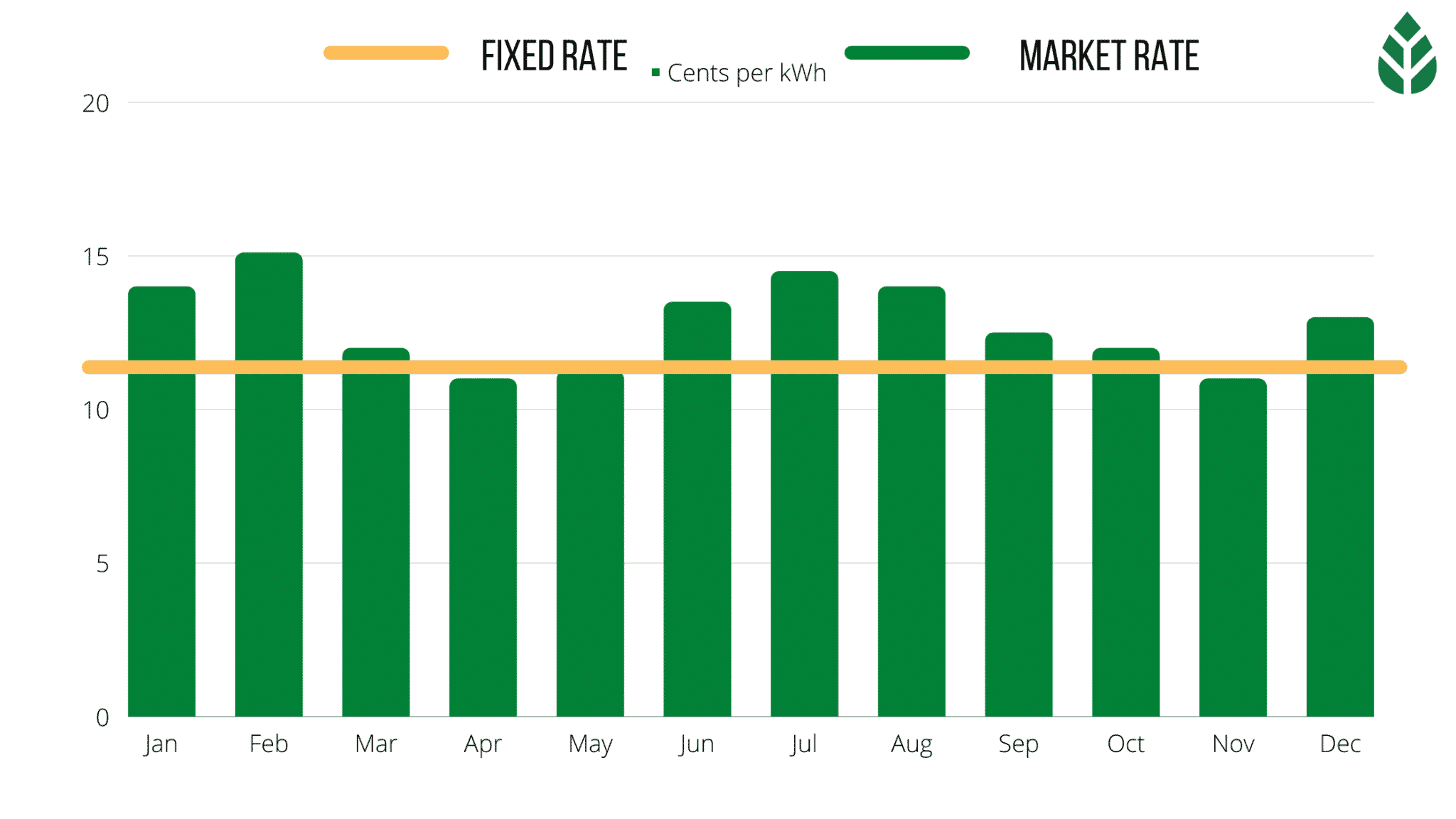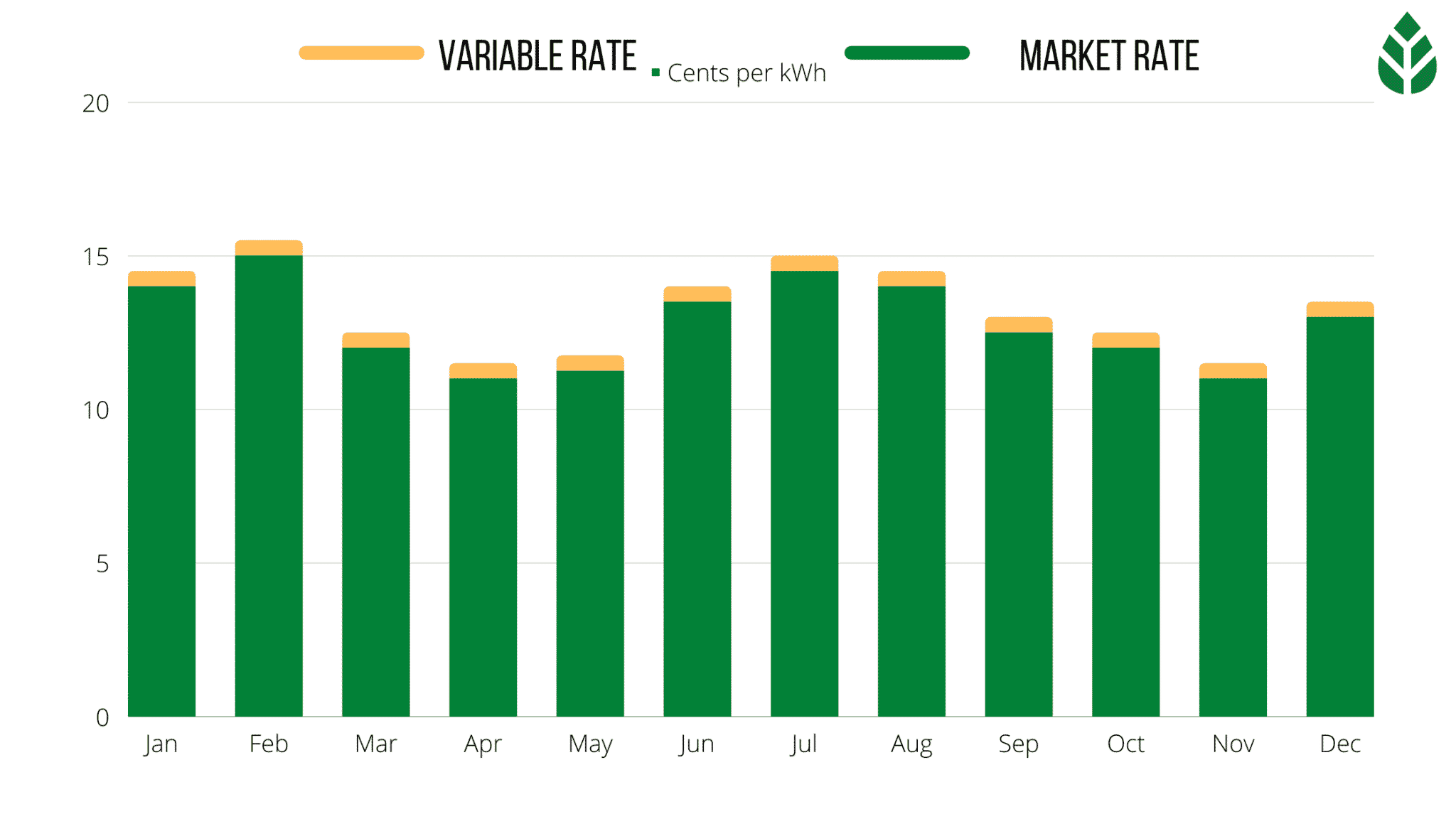
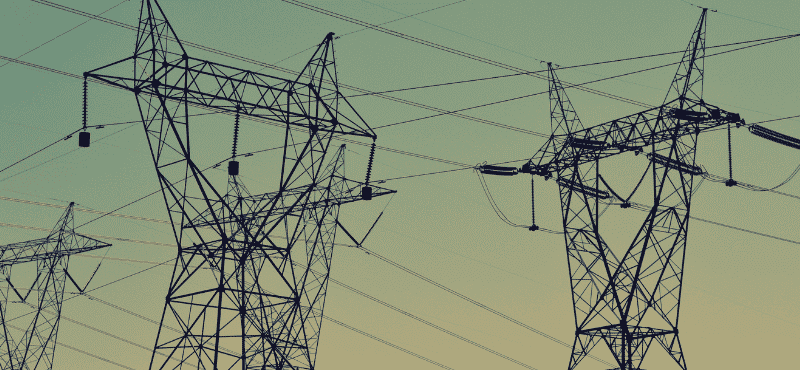
Compare California Electricity Rates (2024 Best Prices)
Here’s a quick overview of California electricity rates:
- Current average retail rate of electricity: 26.71 cents per kilowatt-hour (kWh)1
- Current range of electricity prices in California: 8.27 to 65.46 cents/kWh
- Average monthly electric bill: $134.88
- Average energy usage: 572 kWh
Figures accurate as of time of publication.
Each product and or company featured here has been independently selected by the writer. You can learn more about our review methodology here. If you make a purchase using the links included, we may earn commission.
Who Has the Best Energy Rates in California?
Most of the energy plans in California are time-of-use plans, so the cost per kWh fluctuates based on when your home or business consumes energy. The lowest rate within these plans comes from Clean Energy Alliance (formerly Solana Energy Alliance) at just 8.27 cents per kWh with the CEA Green Impact Premium 100% Renewable Plan. You can click below to compare energy prices from the top electric suppliers in California.
California Energy Rates
California and Texas were the first states to deregulate their electricity markets in the mid-1990s. Since then, ratepayers in California have had an energy choice and can choose their preferred provider.
Energy deregulation increases competition in the industry, which drives down prices and provides you with more options for sourcing your electricity. According to the Energy Information Administration (EIA), the average cost per kWh in California is 26.71 cents, which is far above the national average and second-most expensive after Hawaii.1 However, you could pay anywhere from 8.27 cents to 65.46 cents per kWh, depending on which supplier you select.
Your costs per kWh will also depend on your distributor (your local electric utility), which is the company that maintains the power lines and poles that bring energy to homes and other structures. Utility rates are regulated by the California Public Utilities Commission (CPUC). Many customers in CA are serviced by Pacific Gas & Electric Company (PG&E), but your price for energy can vary if you’re serviced by other utilities, including Southern California Edison (SCE) and San Diego Gas & Electric Company (SDG&E).
Comparison of Electricity Rates in California
The table below compares a number of currently available energy plans in California. It should be noted that EcoWatch promotes the use of clean energy, so we’re only including plans that pull energy exclusively from renewable sources. We recommend these plans over standard ones that rely on fossil fuels. You can learn more about green energy plans further below.
| Plan Name | Term (Months) | Plan Rate* (¢/kWh) |
| Inspire Clean Energy Inspire Fixed 12 | 12 | 10.19 cents |
| CleanPower SF E-1 | 12 | 13.04 cents |
| CleanPower SF E-TOU-C | 12 | 11.64 to 18.02 cents |
| CleanPower SF E-TOU-D | 12 | 10.47 to 20.96 cents |
| CleanPower SF E-6 TOU | 12 | 10.66 to 25.97 cents |
| CleanPower SF E-EV2 | 12 | 10.49 to 19.77 cents |
| Valley Clean Energy E1 | 12 | 15.08 cents |
| Valley Clean Energy E6-TOU | 12 | 12.70 to 28.02 cents |
| Valley Clean Energy ETOU-B | 12 | 12.61 to 27.09 cents |
| Valley Clean Energy ETOU-C | 12 | 13.68 to 20.06 cents |
| Valley Clean Energy ETOU-D | 12 | 12.51 to 23.01 cents |
| Valley Clean Energy EV | 12 | 9.33 to 31.21 cents |
| Valley Clean Energy EV2 | 12 | 12.53 to 21.81 cents |
| Clean Energy Alliance EcoChoice | 12 | 45.48 to 65.46 cents |
| Clean Energy Alliance CEA Green Impact Premium DR Rate | 12 | 8.27 to 38.51 cents |
*Rates will vary based on your public utility; you’ll see the rates above if your utility is PG&E. Rates are subject to change.

Inspire Clean Energy
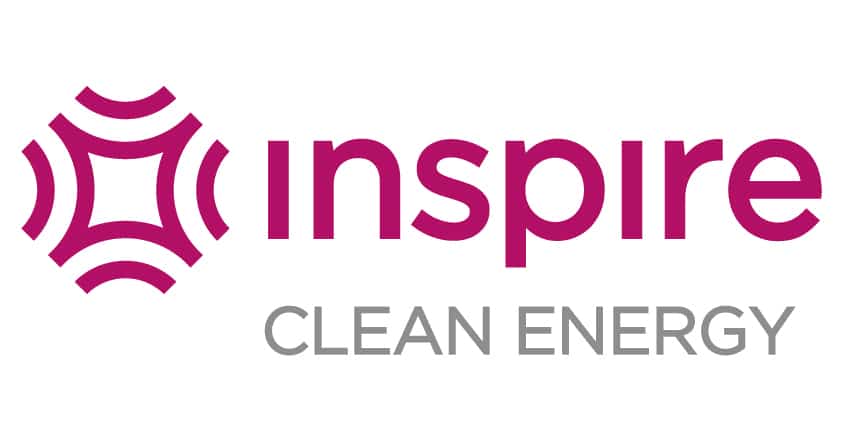
Nationwide Service
Average cost
Pros
- All plans use clean energy
- Certified B Corp
- Great industry reputation
- No sign-up or cancellation fees
Cons
- Relatively young company
- Low number of plans to choose from

Clean Energy Alliance

Local Service
Average cost
Pros
- Low number of customer complaints
- No early termination fees
- Lowest TOU rates at certain times
- Green energy plans available
Cons
- Small service area
- Relatively new company

Valley Clean Energy
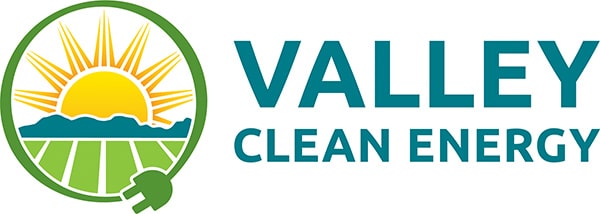
Local Service
Average cost
Pros
- Low number of customer complaints
- Green energy plans available
- Wide variety of contract term options
- Low rates
Cons
- Small service area

CleanPowerSF

Local Service
Average cost
Pros
- Green energy plans available
- Wide variety of contract term options
- No sign-up fees
Cons
- Small service area
How to Find the Best Electricity Rates in California
Looking at the wide range of energy plans available, it might be tempting to choose the one with the lowest per-kWh rate to save money. Unfortunately, that’s not always the best option, especially in California, where most plans are based on when you consume electricity. Below, we’ll discuss two additional factors you should consider when selecting an energy provider in California.
Your Energy Usage
One of the first things you’ll notice about the table above is that the rates for most plans are shown as ranges. This is because most plans in California are time-of-use (TOU) plans. That means your per-kWh rate will depend on when you consume electricity — that is, the time of day and day of the week you use it. TOU plans might be best for you if you find that your home uses most of its energy during off-peak hours or if you can change your energy use habits to use most of your energy during off-peak hours. Peak and off-peak timelines can vary by electric utility, so be sure to check with your utility to see when your peak and off-peak hours are.
Another important consideration is how much electricity you use. Many electric suppliers use a tiered rate plan, which charges different prices per kWh based on how much energy you consume each month on average. Tiered plans typically find customers who use the average amount of energy paying the least, while those who use well above or below the average of 572 kWh per month pay more per kWh. You can check your past electric utility bills to see what your usage is.
Contract Length
You’ll also want to consider the contract length, which is the time you’ll be locked into the energy plan you choose. Many electricity plans have a term of 12 months in California, some have terms of several years, and others have no term or contract at all. Longer contracts typically have lower per-kWh rates, but they also mean you won’t be able to break your contract and potentially get a lower rate for months or years.
In addition to the length of the plan, you should also check your contract for other hidden fees and conditions that can change your experience with your provider. Specifically, you should look for sign-up fees for connection to the electric grid, early termination fees and low introductory per-kWh rates that will go up during your contract term. You can use this tool to make your decision much easier and find the best supplier for your needs quickly.
Types of Electricity Plans in California
Part of the reason it can be so confusing to find the ideal energy plan in California is that there are many different kinds of plans available, and many customers don’t know the differences between them. Below, we’ll explain what the different plan types are and the pros and cons of each to help you decide which is most likely to suit your needs.
Fixed-Rate Plans
Fixed-rate plans are energy plans that include a set rate (or rates) that you’ll pay per kWh for the entirety of your contract. The rate can vary based on when you use the energy — like in a fixed TOU plan — but there are never any surprises when it comes to per-kWh charges. Your bill can change from month to month based on your energy consumption, but your per-kWh price remains constant.
We almost always recommend fixed-rate energy plans to California customers because they provide peace of mind. Your price for energy won’t skyrocket in times of high demand or low supply, and it won’t get bumped up during times of crisis when other plans’ rates might.
| Pros of a Fixed-Rate Energy Plan | Cons of a Fixed-Rate Energy Plan |
| Your energy price never changes throughout your contract | Often have contracts and early termination fees |
| Allow you to budget and save more effectively | You could end up paying more if local energy prices drop |
Variable-Rate Plans
As the name suggests, variable-rate plans have per-kWh prices that fluctuate based on supply and demand. The difference in energy prices month to month or even day to day can be significant, especially if demand increases or the energy supply dips low. If the average market price remains low, you could pay less than with a fixed-rate plan, but it could also remain high and end up costing you much more.
Variable-rate energy plans are suitable for some Californians who don’t mind taking a risk in exchange for the potential to save money, but they provide much less peace of mind than fixed-rate plans.
| Pros of a Variable-Rate Energy Plan | Cons of a Variable-Rate Energy Plan |
| Potential to increase energy savings if local prices remain low | Energy prices can fluctuate unexpectedly |
| No contracts or termination fees | Could end up paying more than a fixed-rate plan if local prices increase |
No-Deposit and Prepaid Energy Plans
Many electric companies require some kind of sign-up fee to set up an account, which they collect to offset losses from non-payment. Some companies offer no-deposit energy plans, which waive the sign-up fee if you’re able to pass a credit check. A good credit score shows the company that you’re likely to pay, which can save you some money in upfront costs.
Another no-deposit option is a prepaid energy plan. These plans require no up-front charges, but you do have to place money in a utility account. All charges for electricity use will be pulled from that account, which means you’ll never pay more than you expect for electricity. On the other side of the coin, you could experience power outages if you forget to top up your account, so they are only ideal for customers who will remember to do so month to month.
| Pros of a Prepaid Energy Plan | Cons of a Prepaid Energy Plan |
| No upfront fees to be paid | You could lose power if you fail to add money to your utility account |
| You will always know the maximum amount you’ll spend on energy | Often come with slightly higher per-kWh charges |
| No early termination fees or lengthy contracts |
Green Energy Plans
Green energy plans are those that generate electricity exclusively via renewable energy sources or offset energy with Renewable Energy Credits. In either case, choosing a green energy plan is highly recommended by the EcoWatch team, as it allows you to take advantage of clean energy without having to invest in special equipment like solar panels, which can often reach into the tens of thousands of dollars. Green energy plans tend to be a touch more costly on average, but there are many options that are still below the average cost of electricity in California.
We should also note that California has set a Renewable Portfolio Standard (RPS) goal of producing a minimum of 60% of its electricity via clean energy sources by 2030.1 In order to hit this goal, green energy plans could be incentivized and become more readily available. As a result, you could have more options for 100% renewable energy plans in the future, and they could be even more affordable than they are now.
| Pros of a Green Energy Plan | Cons of a Green Energy Plan |
| Produce much less carbon emissions and pollution | Often a bit more expensive per kWh than standard plans |
| Lets you get behind the clean energy movement without investing money in equipment like solar panels | Fewer options currently available than those that use fossil fuels for electricity generation |
Business Energy Plans
The last option available is a business energy plan, which is designed to meet the higher energy needs of commercial and institutional buildings like businesses, religious and educational institutions, government agencies and other large entities. These plans are not available to residential customers, and they’re often less expensive than residential rates. You’ll also have fewer options if you need a business plan and might need to do a bit more research.
Electricity Companies and Providers in California
California’s move to energy deregulation means that all homeowners have an electric choice and can select providers based on what fits their budgets and energy needs. This is generally a positive thing, but it does mean your decision on an electric supplier can take some time and thoughtful research. We recommend starting with our top-rated suppliers in California, described below.
Inspire Clean Energy
- 100% renewable energy plans available
- Fixed-rate plans offered
- Generally positive customer reviews
- No early cancellation fees
- No sign-up fees
Clean Energy Alliance
- Mostly positive online reviews
- No early termination fees
- Lowest TOU rate at certain times
- Green energy plans are available
Valley Clean Energy
- Positive online reviews
- Green energy plans are available
- Many different rate plans offered
- Generally low prices
CleanPowerSF
- Clean energy plans are available
- Fixed-rate plans offered
- Many different plans and rates to choose from
- No sign-up fee
What to Look For When Choosing an Electricity Provider in CA
It’s often tempting to choose the plan that offers the lowest per-kWh rate. However, finding the best supplier for your energy needs will take a little more research. Below, we’ll outline some of the top factors to consider when selecting a new electric supplier.
- Plan Type: Most plans in California are TOU plans, but you should always confirm what type of plan you’re choosing. Not all plans are suitable for all customers, so you should narrow your search first by plan type.
- Energy Source: Next, you can rule out some plans based on how they source their energy. We strongly recommend choosing a 100% renewable energy plan, which costs around the same as other plans on average and immensely benefits the environment.
- Per-kWh Rates: The price per kilowatt-hour (kWh) is an important consideration as it will ultimately determine what you pay for energy. Make sure you factor in introductory rates that can change over the course of your contract.
- Contract Terms: In addition to the cost per kWh, you’ll want to consider other terms like the length of the contract, the sign-up fee, early cancellation fees, and more. Additionally, given the prevalence of electric vehicles in California, some contracts have clauses or incentives for homes with EVs.
- Customer Satisfaction: We recommend looking at some positive and negative reviews for each electric supplier you’re considering. This can often help you predict what kind of service you’ll be receiving after signing up.
- Company Longevity: Finally, look at how long the company has been serving customers. Companies that have many years of experience are more likely to be able to provide excellent customer service.
FAQ: California Electricity Plans
The EcoWatch team gets lots of questions from California residents about energy plans available and how to choose the best one. We’ll provide answers to some of the most common questions we see below.
It’s difficult to say which electric supplier in California has the lowest rates because most companies use a time-of-use structure with rates that vary based on when you use the energy. However, the lowest rate overall is 8.27 cents per kWh from Clean Energy Alliance. The CEA Green Impact Plan offers this low rate as a part of its GEVTOU-2 rate structure.
There is no single energy provider that will appeal equally to all electricity consumers. The best energy provider for you is one that meets your energy needs and preferences and fits into your budget. With that being said, our top-rated energy supplier in California is Inspire Energy. This company has green energy plans available, is relatively affordable, includes no sign-up fees or cancellation fees, and has generally positive reviews online.
The average homeowner in California pays $134.88 per month for electricity. This figure is based on the average rate of 23.58 cents per kWh and the typical household consumption of 572 kWh per month.
Since the energy market in California is deregulated, one of the easiest ways to lower your energy bill is to choose a more affordable electric supplier. Doing so can instantly lower your energy bills, and switching to a green plan can reduce your carbon footprint at the same time.
You can also reduce your electricity usage by making some energy-efficient upgrades in your home. Some examples include replacing windows and doors with more energy-efficient options, replacing insulation, resealing around wall openings, installing a smart thermostat, and replacing your light bulbs with Energy Star bulbs. We have more tips in our guide to improving home energy efficiency.
Just as with electric companies, there is no single energy plan that will suit all California homeowners. Choosing the best plan for you involves assessing the available options based on price per kWh, contract terms, contract length, energy source and more. We recommend starting your search with some of our top companies, which include Inspire Energy, Clean Energy Alliance, Valley Clean Energy and CleanPowerSF.

 233k
233k  41k
41k  Subscribe
Subscribe 
